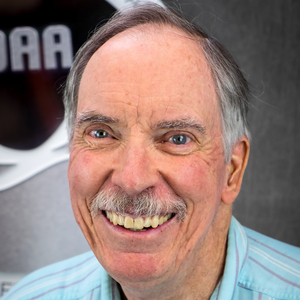John Brown: GSL Scientist Emeritus


Dr. John Brown is retiring after an extraordinary, multi-faceted four-decade career of contributions to the NOAA weather community that has served the nation. He will return as GSL’s first Scientist Emeritus.
Dr. Brown’s exceptional command of meteorology at convective, meso-, and synoptic scales, and mastery of modeling techniques and physics concepts have translated into valuable contributions to NOAA’s National Centers for Environmental Prediction physics parameterization development for more than 20 years. He has been a lead scientist for the Weather Research and Forecasting model Physics Working Group since 2002 and a co-developer for land-surface models, planetary boundary layer schemes, and cloud physics parameterizations. Dr. Brown’s work guided the development of the regional Rapid Update Cycle (RUC), Rapid Refresh (RAP), and High-Resolution Rapid Refresh (HRRR) models. The HRRR is the only hourly-updating high-resolution, rapidly-updating. high-impact weather model in the world. Dr. Brown also contributed to the Flow-following finite volume Icosahedral Model (FIM), Global Forecast System (GFS), Finite Volume Cubed Sphere (FV3), and FIM-HYCOM global models with physics development and evaluation.
Dr. Brown has been a major contributor to NWS/COMET forecaster training to readers of WeatherWise magazine through the “Weather Queries” column, Dr. Brown’s commitment to advancing the science of weather forecasting is tireless. He has faithfully documented weather observations as the lead Cooperative Observer on the NOAA Boulder campus now for 31 years. Dr. Brown has been a student of weather since childhood, and his natural curiosity has made him an esteemed lifelong learner, practitioner, and teacher. What makes him special, according to his colleagues, is his ability to link theoretical meteorology with real-world weather and share that knowledge with people of all abilities.
Dr. Brown has taught a wide range of meteorology courses, and his counsel and expertise have influenced material in graduate-level textbooks on severe convective storms that now inform hundreds of students. He has served on many Ph.D. committees for candidates at Colorado State University, University of Colorado, University of Oklahoma, and the University of Miami. Dr. Brown is a sought-after mentor and role model, and many of his pupils have become leaders within the NOAA weather forecasting community such as Stan Benjamin, Georg Grell, Tanya Smirnova, Jian-wen Bao, and Joseph Olson.
Dr. Brown has been a quiet, guiding force as a specialist in weather interpretation. He has developed and tested original forecast techniques and applications for difficult weather problems including cold-air damming, lee-cyclone development east of the Rockies, nocturnal convective storm initiation over the High Plains, and the genesis of Atlantic and Eastern Pacific tropical cyclones. Dr. Brown has also been an annual participant in the NOAA Hazardous Weather Testbed Spring Forecast Experiment since its inception in 2002. Many NOAA field projects have relied on his forecasting expertise for successful deployments from 1979-2016, including Pre-STORM (1985), STORMFEST (1992), IHOP (2002), MPEX (2013), FRAPPE, and the El Nino Rapid Response (2015-16).
Dr. Brown has served on the AMS Committee on Mesoscale Processes and on the program committee for the 16th AMS Conference on Severe Local Storms. He was also a co-author for an AMS monograph chapter on 100 years of progress in forecasting and NWP applications for forecasting. His work protects the scientific integrity valued by NOAA.
Dr. Brown’s lifelong endeavor to increase understanding of hazardous atmospheric phenomena and predicting the atmosphere and to share his expertise through mentoring and modeling is a gift to the weather forecasting community.
Awards
2020 - American Meteorological Society (AMS) Charles L. Mitchell Award: John Brown for selfless dedication during more than four decades of service in developing forecast techniques, advancing model performance, training forecasters, and forecasting for large field programs.
2017 - NOAA Technology Transfer Award. “For improving forecasts of turbine-height winds and solar irradiance from their High-Resolution Rapid Refresh weather model to improve usage of renewable power by industry.”
2015 - US Dept. of Commerce Gold Medal - group citation for the NOAA/ESRL/GSD Assimilation and Modeling Branch. John Brown was one of the 5 Federal scientists receiving this citation for HRRR development and implementation at NCEP in 2014.
2015 - Colorado Governor’s Award for High Impact Research - for the development and implementation of the High-Resolution Rapid-Refresh (HRRR) weather model. The HRRR next-generation weather model runs hourly and brings in data from many sources to help provide critical details to forecasters in rapidly changing and evolving weather events.
2010 - US Dept. of Commerce Bronze Medal - For Rapid Refresh Development Team
2006 - NOAA/OAR - Outstanding Scientific Paper Award (with co-authors) for “An hourly assimilation and forecast cycle: The RUC. Mon. Wea. Rev., 132, 495-518.
2005 - NASA Group Achievement Award for contributions to the Helios Mishap Investigation, 2005.
1998 - Department of Commerce Silver Medal - Co-recipient (with other members of the RUC / MAPS team)
1991 - Editor’s Award from the American Meteorological Society. For providing exceptionally meritorious reviews of manuscripts submitted to the Journal of Atmospheric Science
